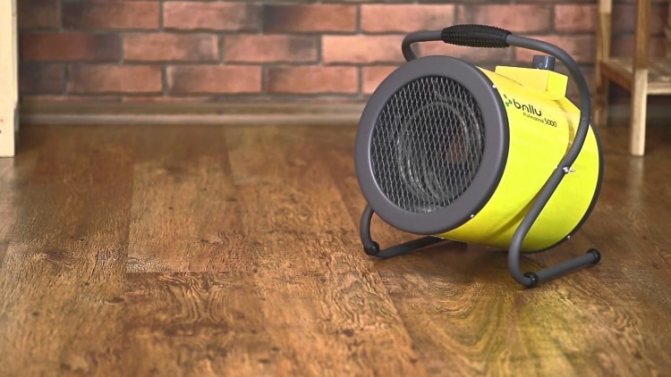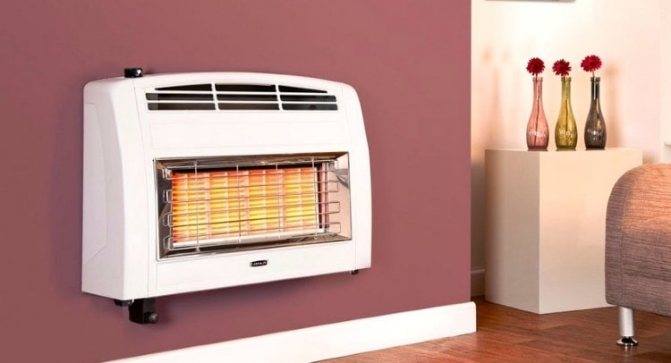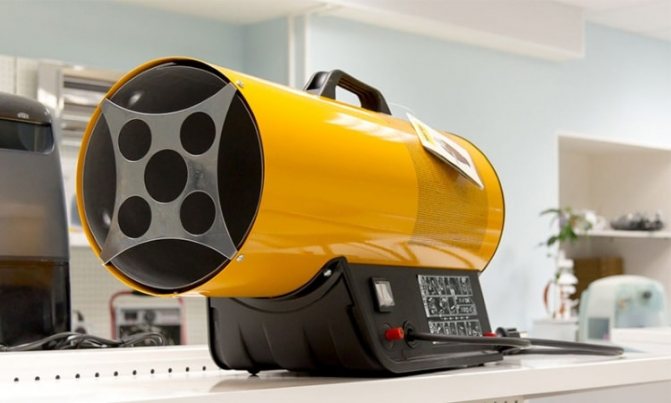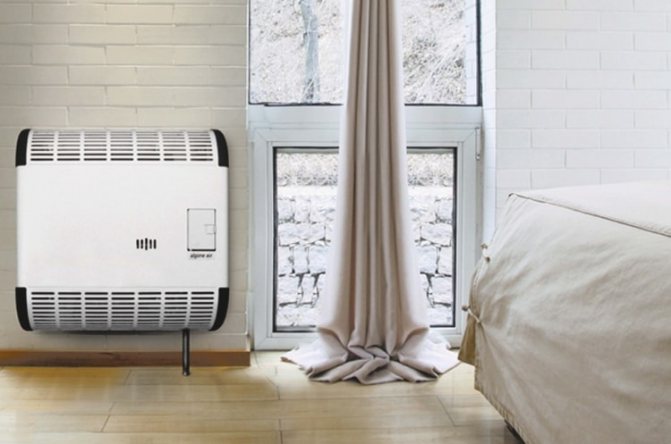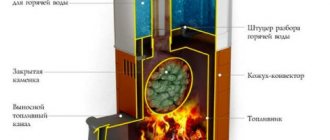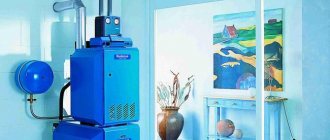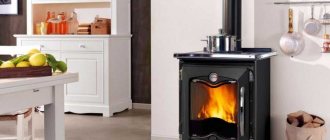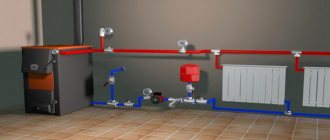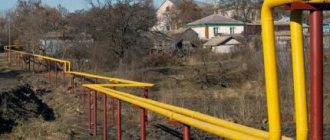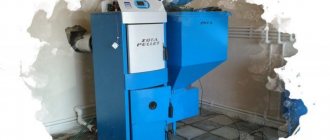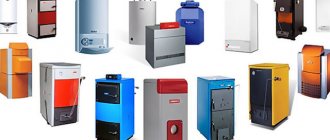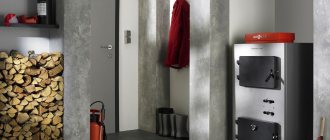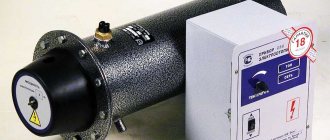Gas bottle
Gas cylinders known to all - these are metal oblong vessels of various volumes, containing compressed gases under high pressure inside. Structurally, a household gas cylinder consists of a cylindrical part, a bottom and a neck. Valves, flanges and other sealed communicators are used to connect the cylinder.
This applies to the most common types... In addition, spherical gas cylinders are produced, but they are not used for domestic purposes.
Thanks to its compactness and availability, gas cylinders are often used for domestic purposes. In addition, they are easy to transport, do not take up much storage space and are easy to use when needed. And even this is not all the advantages of a gas cylinder for a summer residence.
Independence from a centralized gas pipeline and / or power supply. Even if there are these communications on the site, you are insured in case of their disconnection, accidents and other unforeseen circumstances. By the way, this is a reason to buy a gas cylinder even if there is a gas pipeline.
Control and savings... You yourself decide and regulate how much gas to use, what the pressure will be, which devices to connect to the source. This makes sense, especially if you have a large number of tenants and / or if you are renting out the cottage.
Not only metal are produced, but composite cylinders... Not only do they weigh much less, but their walls are also transparent. And you can see how much LPG is left in stock, how soon you need to refuel the gas cylinder.
Gas bottle can be called a useful acquisition without exaggeration. But only on condition of strict observance of all safety requirements.
Gas Leakage Procedure
If there is a clear smell of gas, it is recommended to tighten the cylinder valve, turn off the stove and open the windows. For intensive ventilation, you can open windows not only in the kitchen, but also in other areas of the apartment. A high concentration of a substance in the air is a reason to seek the help of specialists, to call representatives of the municipal gas service to your house.
It is forbidden to use lighters and matches, light a cigarette, turn on the stove. Until the leak is repaired, do not use devices that require an electrical connection. Before the arrival of the brigade, all residents of the apartment (including animals) must leave the premises.
To avoid poisoning and more tragic consequences of a leak, you can use special sensors or gas monitoring kits. Equipped with light and sound alarms, these devices will inform about the problem before the smell is noticeable.
Gas in a cylinder: safety at home
Inside a household cylinder there is natural hydrocarbon gas under high pressure. Excessive pressure converts the gas into a liquid state of aggregation. When leaving the cylinder, the liquefied gas returns to its previous state. If you delve deeper into understanding this process, it turns out that:
Hydrocarbon gas Is a mixture of butane, propane, ethane and methane. A complex composition is required to create certain properties of the gas mix. Inside the balloon not all of the gas is in a liquid state. Rather, it can be called a two-phase content: liquid, and gas above it. The higher the pressure, the more liquid.
When leaving the cylinder the liquid literally evaporates, acquiring a gaseous state necessary for domestic use. Structure LPG cylinders may vary slightly.At the same time, all hydrocarbon gases are explosive and easily ignited by any careless handling.
They have a specific, recognizable odor so that you can spot the leak in time. According to the degree of toxicity, they are assigned to the IV class of hazard (“low-hazard substances”). It's true: even perfumes and deodorants use liquefied petroleum gases.
So do without gas bottle in everyday life it is not necessary. Moreover, according to the law, all produced gas cylinders undergo a mandatory technical check and receive supporting documents (the so-called "passport").
You can (and should!) Check for a stamp when purchasing a cylinder. It is located near the neck and contains information about the date of manufacture of the cylinder, expiration date, nominal volume and weight.
Propane tank characteristics
Propane cylinders are available in various volumes. They contain between five and fifty liters. They are intended for storage and transportation of gas. They are used in gas welding and for domestic heating.
Cylinders may differ in operating pressure limit for liquefied gases. For propane, it is a maximum of 1.6 MPa. Liquefied gas has a high volumetric expansion coefficient. For this reason, the cylinders are filled so that there is enough air in them to absorb the liquid, which will expand during heating.
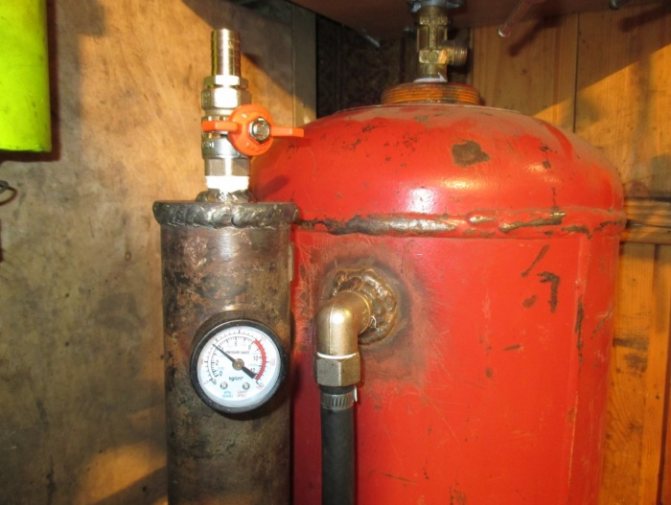
A 50 liter propane cylinder is equipped with a valve, as well as protective rings and a safety cap. Outside, each container is painted with weather-resistant paint. It is always red.
Technical characteristics of propane cylinders:
- container capacity is 50 liters;
- working pressure indicator does not exceed 1.6 MPa;
- cylinders must withstand test pressure within 2.5 MPa;
- the container collapses at a pressure of more than 5 MPa;
- excluding protective rings, the cylinder diameter is 299 mm;
- the walls are 3 mm thick;
- the balloon is 980 mm high;
- an empty container weighs 22 kg;
- the mass of liquefied gas is 23 kg.
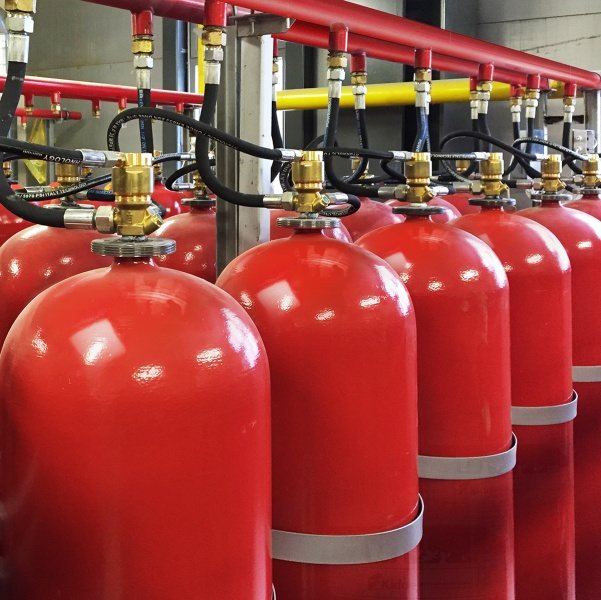

Interesting! Propane is a hydrocarbon gas that contains between 75% propane and propylene.
Propane is a fossil fuel. This substance is odorless and colorless. Propane is found in associated and natural petroleum gases. It is also obtained from oil refining. Due to its chemical and physical properties, it has gained wide popularity in production and everyday life. It is also used during construction work.
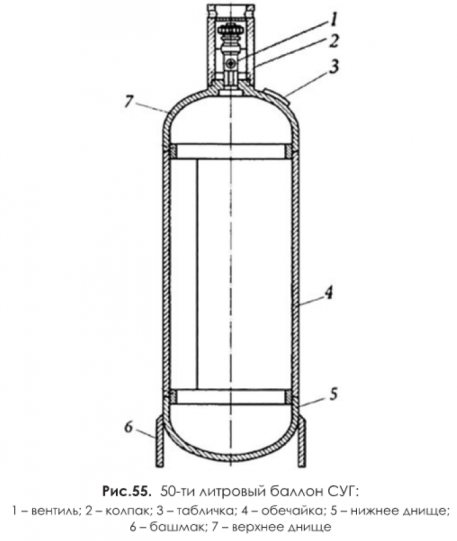

If you use liquefied gas for the heating system, the best choice would be to buy 50 liter cylinders. They are filled with a mixture of propane and butane. It becomes liquid when exposed to high pressure. The following fuel combinations can also be used:
- summer mixture of butane with propane - SPBTL;
- winter - SPBTZ.
Choosing and buying a safe gas cylinder for a summer residence
Of course acquire and use only cylinders that have passed a full test and provided with an official stamp are allowed. But it cannot be otherwise if you buy gas cylinders only from legal suppliers. You must be presented with a license. After that, you can safely explore the range.
By volume gas cylinders can be very small (5 liters), as well as 5, 12, 27 and 50 liters.
When choosing, take into account the number of appliances to which you will connect the gas (stove, heater, etc.); the number of people in the house; free space for safe storage of the cylinder (we will talk about this in more detail in the next part of the article).
Cylinder material... The usual option is a metal cylinder, one-piece or with welded seams.
Modern version: Composite balloon, lightweight and transparent to control the amount of content. Composite cylinders are considered safer (less risk of explosion).But these advantages will have to be paid for about three times more than metal cylinders of similar volume can cost. Even the smallest, 5-liter, gas cylinder will come in handy at the summer cottage if the house is not heated there. This fully applies to cabins, log houses, block containers and even logs. With the help of gas, you can both heat the house and create comfortable conditions in it (heating water, cooking, etc.).
Where to buy and refuel?
The container itself can be purchased in hardware stores, on specialized online portals. Municipal gas services will help you to replace or fill it. In the event that the consumer plans to independently deliver gas to his home, the seller is obliged to give comprehensive instructions for the transportation, installation and testing of the equipment.
We also recommend reading our other article, where we talked in detail about the technical requirements for gas cylinders and the technology for filling them. More details - follow the link.
People who have successfully completed the training are given reminders on all stages of handling the equipment and a certificate for unhindered replacement of the emptied container in the future.
The main difference between the models available today is the design of the locking device. The valve can be seen on earlier products.
Modern products are equipped with a valve. According to the conviction of professional gas workers, the valve is more convenient and safe for use in everyday life. And the valve device is better to give preference to long-term storage.
Safe storage and operation of a gas cylinder
Even initially serviceable A gas cylinder can be dangerous if used incorrectly. And rightly so - it's not difficult at all. Here are the basic conditions:
Passport stampassigned to a cylinder in production does not guarantee eternal preservation. In particular, the gas cylinder can be damaged during transportation, from impacts and / or falls.
A sign of such damage is dents, deep scratches, cracks, other violations of the integrity of the cylinder or its parts (neck, valve, etc.). It is dangerous to use such a bottle or even leave it in the house.
Temperature regime very important for gas cylinders. Do not store, use, move them at temperatures over 45 ° C. Exceeding this line can lead to a jump in internal pressure and an explosion of the gas cylinder. Sudden changes in temperature are fraught with the same consequences. And too low ambient temperature makes the walls of the cylinder brittle.
Gas cylinder you need sufficient storage space, and it depends not only on the dimensions of the cylinder itself. First, you need free access to the cylinder, as well as the ability to take it out of the room. Secondly, in order to comply with the temperature regime (see paragraph above), it is imperative to move the cylinder away from all devices that can heat it (2 meters from the stove, 1 meter from batteries and heaters). Storage room and the operation of the gas cylinder must meet certain requirements. Thus, the balloon should not be exposed to direct sunlight. Do not leave the cylinder in the aisle, where it can be touched, moved, dropped.
Gas cylinders small volumes (5 and 12 liters) can be stored in a common room. There can be only one cylinder with a volume of 27 or 50 liters in a room, regardless of the size of this room.
Often per balloon girdle rubber rings are worn for safety. They are usually used for transportation, but they will not interfere with the cylinder set on the floor. Many owners store gas cylinders in a residential building or shed for easy access to them.
But in fact, according to the rules, gas cylinders must be installed outdoors: on the street, in a tightly closed metal cabinet or booth.Always upright! Make sure that there is no sunlight and precipitation inside.
Read more about the shtil chainsaw and its repair with us.
Are you decorating a barbecue area in the country? With these tips - get it right!
Build your own dog house by following these important guidelines.
Why are gas heaters good for summer cottages?
Gas heaters work equally well with natural gas and propane gas.
To begin with, gas heaters can work regardless of the presence of any communications and networks. So, no plumbing with sewerage or electricity is required. Even a central natural gas supply is not needed. All you need is a bottle of liquefied gas. At the same time, a gas heater for a summer residence, according to reviews, may well operate on the gas that is centralized through the gas pipeline, that is, from natural gas.
Based on this, it turns out that a gas heater for a home can be used anywhere, even in the deep taiga, even in a high-rise apartment, even in a tent on the summit of Everest. By the way, it should not be forgotten that in the mountains at high altitudes the pressure is not the same as on the plain, so you need to use special cylinders. A gas heater for an apartment is a very mobile device. They vary depending on the heating method, even though they all use the same type of fuel - natural gas or liquefied gas.
According to the principle of operation, two groups of devices are distinguished:
- those that heat objects;
- those that warm the air.
Gas heaters for apartments, which heat objects, work on the principle of the already well-known electric infrared heaters "Ufo". If the object is in the radiation range, then it heats up, and if not, then it remains cold until the heat reaches it indirectly, which we will talk about a little later. In the case of air heating, everything is quite simple and straightforward.
In different situations, one or another gas heater is used. The need for heating can arise both indoors and outdoors. Based on this, the following classification of gas heaters for summer cottages with a cylinder can be distinguished:
- for confined spaces;
- for open spaces (hangars, agricultural structures);
- for the street.
Below we will consider the main types of gas heaters for summer cottages with a cylinder individually, their characteristics, as well as areas of application.
When choosing pipes for heating a private house, pay attention to the certificates from the sellers so as not to purchase low-quality goods.
In a gravity system, the slope of the heating pipe is of key importance and must meet the requirements specified here.
Refueling and connecting a gas cylinder to household appliances
Gas bottle can serve as a source of fuel for heaters, water heaters, kitchen stove. To securely attach the cylinder, you will need:
- special flexible gas hose. The admissible hose diameter is from 6 to 9 mm;
- a clamp for fixing the hose to the cylinder and a clamp for fixing the hose to the device;
- reducer type RDSG 2-1.2 (for a cylinder with a valve) or RDSG 1-1.2 (for a cylinder with a valve).
It is highly desirable that installation performed by specialists. Moreover, you still have to invite a master from time to time to fill an empty gas cylinder for a summer residence. Refueling gas cylinders - this is the specialization of professional licensed companies, only in this case you can count on the safety of both the process and the result.
And in no case should you try to get by on your own. Refueling gas cylinders refueling is strictly prohibited! If you cannot wait long for the visit of the master, keep spare gas cylinders for the summer cottage. Because this is precisely the situation where caution is never over-cautious.
And for those who like to know more, we suggest that you familiarize yourself with the video about gas cylinders
Gas mixture selection using Primus as an example
Primus summer gas
The fuel mixture consists of butane and propane, and is not much different from those used 30-40 years ago. Gas ensures stable operation of burners and stoves at temperatures from + 40 ° C to + 15 ° C. If the thermometer drops below, then first the fuel consumption increases, and then the stability of operation is lost - the burner begins to "puff" and gradually extinguish.
Summer gas mixtures include most of those sold today - Snow Peak silver cylinders, Campingaz gas, most mixtures in tall collet cylinders.
Primus Power Gas
Previously called "Primus 4 seasons" and is a mixture of propane and isobutane. Provides correct operation in the widest temperature range from + 25 ° C to -15 ° C.
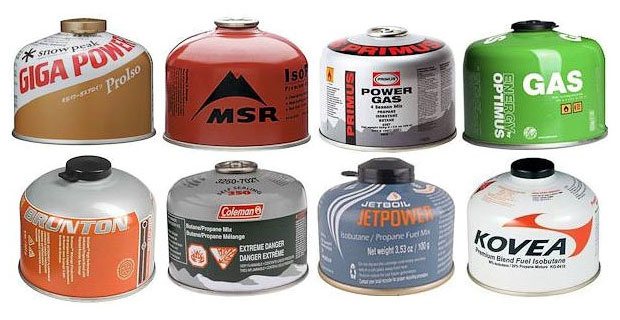

Cylinders from various manufacturers containing isobutane in the mixture
Primus Winter Gas
These cylinders use the same isobutane-added gas mixture as other "winter" formulations from other manufacturers. However, the Swedish manufacturer has significantly improved the design of its cylinders. A microporous Vapor-Mesh "blotter" napkin was introduced into their cavity, which helps the gas to pass from a liquid to a gaseous state at low temperatures.
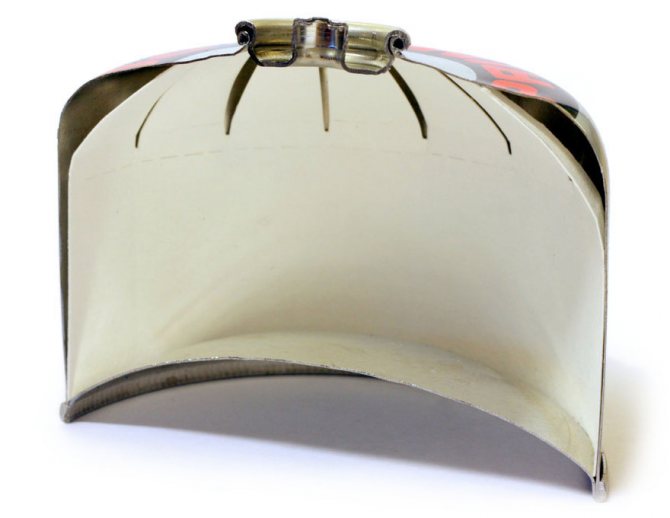

Sectional view of Primus Winter gas cylinder This allowed us to lower the maximum temperature of use to -22 ° C. So far, this novelty is a unique feature of Primus, but it is possible that in the future we will see cylinders of this design from other manufacturers.
In the warm season, the composition of the gas mixture is of no fundamental importance. For users who use fuel equipment from spring to autumn, gas cylinders are suitable, which can operate at temperatures down to -15 ° C. Primus Winter Gas is designed for the most extreme temperatures encountered during winter mountaineering, skiing trips and more.
Remember that the closer a gas is to its lower temperature limit for use, the less efficiently it is used. Therefore, before use, it is advisable to warm the gas cylinder in your hands and shake it several times.
Most manufacturers of portable fuel equipment recommend using their burners only with their own "branded" cylinders. This is done solely with the aim of absolving itself of responsibility for the use of low-quality gas by buyers. Therefore, there is nothing wrong with using gas cylinders from other trusted manufacturers, for example, using a Primus burner with a Kovea gas cylinder. Related article
How to choose a tourist gas burner?

